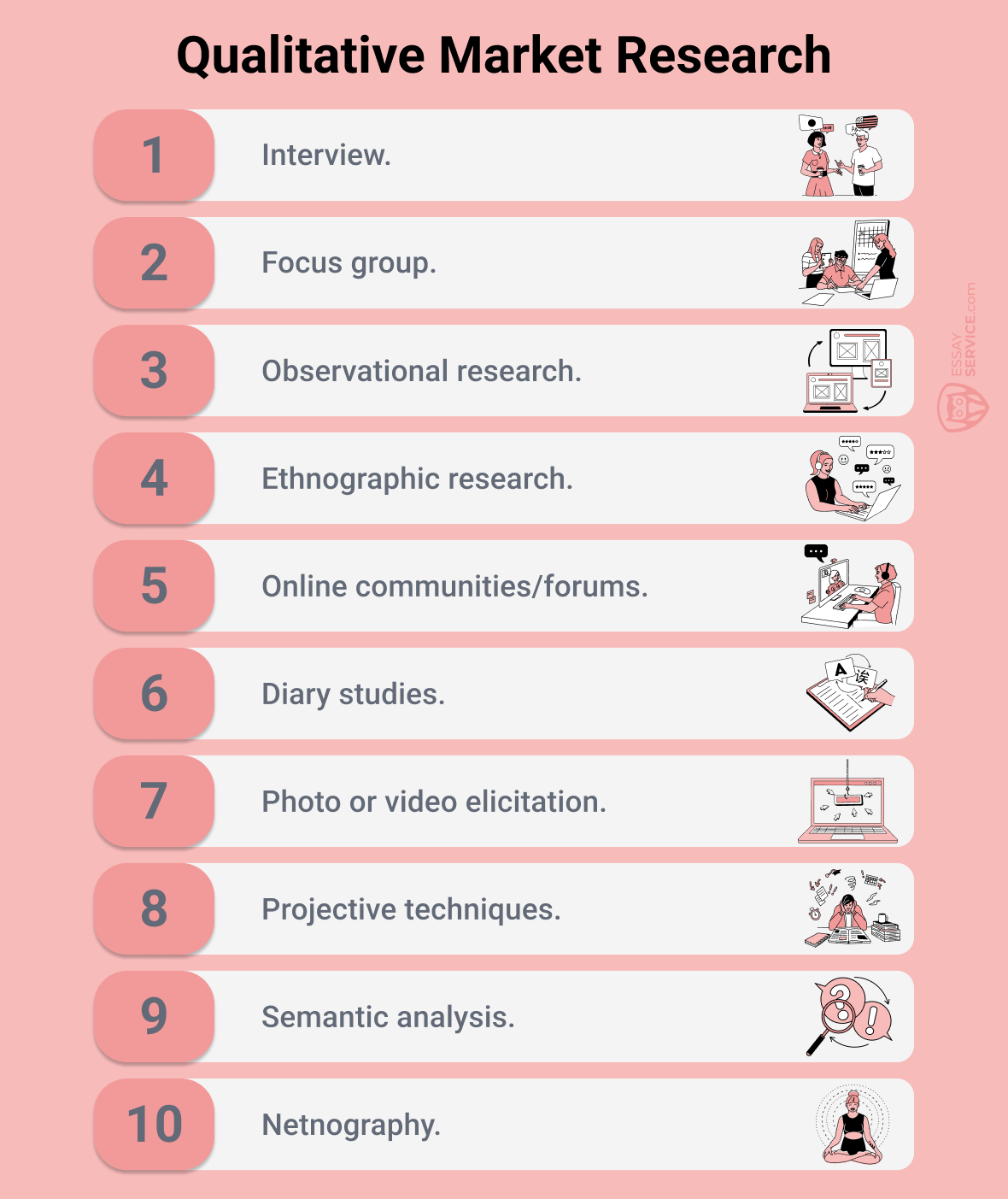
Qualitative Market Research: Definition and Methodology
What makes consumers tick? This knowledge is essential for marketing success, which is where qualitative market research comes in.
It's not just about crunching numbers – it's about digging deep into why people buy what they buy! By exploring their emotions, experiences, and desires, a qualitative analysis gives businesses valuable insights they can't get from surveys alone.
In this article, we'll examine qualitative market research methods, why they matter, and how they help businesses make smarter decisions.
What is Qualitative Market Research?
Qualitative market research is a method of gathering intelligence into consumer behavior and preferences through in-depth exploration of their attitudes, perceptions, and motivations.
It aims to uncover the nuances and complexities of buyer decision-making processes, providing businesses with a rich, contextual understanding to inform product development, marketing strategies, and overall brand positioning.
Unlike quantitative methods, which focus on numerical data, qualitative research employs interviews, focus groups, and observation to investigate the underlying reasons behind shopping actions. If you want to know more about qualitative and quantitative research, this guide provides a detailed analysis.
Methods and Techniques of Qualitative Market Research
Here are ten common methods and techniques used in qualitative market research:

Interviews
Marketers conduct one-on-one interviews with participants to explore their attitudes, beliefs, and experiences in detail. Compared to group settings, these interviews allow for deeper perception and more personal responses.
Focus Groups
A moderator leads a discussion with a small group of participants (typically 6-10 people) to gather diverse perspectives on a specific topic. Focus groups encourage interaction and idea exchange among participants, uncovering collective opinions and attitudes.
Observational Research
Marketers observe participants in their natural environment to understand behavior without direct interference. This method can provide valuable takeaways into real-world interactions and habits.
Ethnographic Research
Marketers immerse themselves in the culture or environment of the target audience to gain a deep understanding of their behaviors, preferences, and social dynamics. This method often involves extended periods of observation and participation.
Online Communities/Forums
Creating online communities or forums allows marketers to engage with participants over an extended period, facilitating discussions, sharing content, and gathering sagacity in a digital environment.
Diary Studies
Participants keep journals or diaries documenting their thoughts, experiences, and activities over a specified period. Diary studies provide rich, real-time data on behavior and attitudes as they unfold.
Photo or Video Elicitation
Participants are asked to take photos or videos related to specific topics or experiences, which are then used as prompts for discussion during interviews or focus groups. This visual method can uncover deeper foresight and evoke emotional responses.
Projective Techniques
These involve asking participants to respond to ambiguous stimuli, such as images or scenarios, to reveal subconscious attitudes and motivations that may not surface through direct questioning.
Semantic Analysis
Researchers analyze language use in interviews, focus groups, or online discussions to identify recurring themes, patterns, and sentiments. This method helps uncover underlying meanings and perceptions.
Netnography
This involves studying online communities, social media platforms, and digital interactions to understand shopping behavior, preferences, and trends in the virtual realm. Netnography leverages existing online data to gain sapience into consuming cultures and online communities.

How to Conduct Qualitative Market Research in 5 Steps?
Qualitative market research involves a strategic approach to gathering shopper behavior and preferences knowledge. Here are five key steps to conduct a qualitative market analysis effectively:
Define Objectives and Research Questions
Begin by clearly defining the objectives of your research and the specific questions you aim to answer. Whether it's understanding client perceptions of a new product or exploring attitudes towards a brand, having well-defined objectives will guide the entire process.
Select Appropriate Methods and Techniques
Choose the qualitative research methods and techniques that best align with your goals and target audience. Options include in-depth interviews, focus groups, observational research, and online communities. When making your selection, consider factors such as budget, timeline, and the depth of insights required.
Recruit Participants
Identify and recruit participants who represent your target market or audience. This may involve screening individuals based on demographic criteria such as age, gender, income, or psychographic factors like lifestyle and interests. Ensure that your sample size is sufficient to capture diverse perspectives while maintaining focus on your objectives.
Conduct Research Activities
Execute your chosen methods and techniques according to your plan. Whether conducting interviews, facilitating focus groups, or observing buying behavior, maintain a neutral and non-biased stance to encourage honest responses from participants. Use open-ended questions to elicit detailed insights and probe deeper into relevant topics.
Analyze and Interpret Findings
Once data collection is complete, analyze the qualitative data to identify patterns, themes, and insights. This may involve transcribing interviews, coding responses, and categorizing key findings. Look for commonalities and discrepancies among participant responses to uncover meaningful insights that address your initiatives.
Finally, interpret the findings in the context of your business goals and use them to inform strategic decisions, such as product development, marketing strategies, or customer experience enhancements.
4 Types of Qualitative Market Research Testing Methods
Qualitative market research testing methods encompass a range of approaches to understanding customer behavior, perceptions, and preferences in depth. Here are four common types of qualitative market testing methods:
Qualitative Market Research Pros
- Qualitative research provides a detailed understanding of consumer attitudes and motivations.
- It adapts to different research needs and allows for customized approaches.
- Ideal for uncovering new trends and opportunities.
- Offers rich, in-depth insights into money-spending behavior.
- Captures subconscious influences on customer choices.
- Fosters participant interaction for more genuine responses.
- Allows for continuous refinement and learning.
Qualitative Market Research Cons
- Findings can be biased due to interpretation and may not apply to broader populations.
- Requires significant time and resources.
- Analyzing data can be challenging and hard to quantify.
- Participants may provide socially acceptable responses.
- Findings can be misinterpreted without proper expertise and are not easily scalable for large studies
Qualitative Market Research Examples
Here are two examples of qualitative market research for your inspiration:
Frequently asked questions
What Is Qualitative Research in Marketing?
This method involves exploring consumer behaviors, attitudes, and motivations in depth. It focuses on understanding the 'why' behind client actions through interviews, focus groups, and observation, providing nuanced insights into user perceptions and preferences.
How Is Qualitative Research Used in Marketing?
It is used in marketing to gather rich, detailed insights that inform strategic decision-making. It helps marketers understand shopping needs, develop effective messaging and branding strategies, refine product designs, and identify emerging market trends and opportunities.
What Is the Difference between Qualitative and Quantitative Market Research?
The main difference lies in their methodologies and objectives. Qualitative research seeks to understand the depth and context of buyer behavior through open-ended questions and exploratory techniques. In contrast, a quantitative analysis collects numerical data to quantify trends, relationships, and patterns within a larger population.
- Qualitative Market Research | Emerald Insight. (2024). https://www.emerald.com/insight/publication/issn/1352-2752
- Market research: qualitative and quantitative data - Market research - Edexcel - GCSE Business Revision - Edexcel - BBC Bitesize. (2023, January 19). BBC Bitesize. https://www.bbc.co.uk/bitesize/guides/z6y9rj6/revision/5
New posts to your inbox!
Your submission has been received!




.webp)